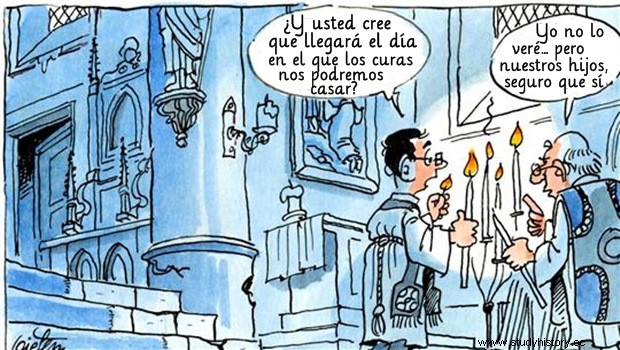There is a popular saying that «Clergymen know more about women than married men; if it were not so, they would also get married «. Leaving aside this saying, somewhat derogatory for women who pass by the altar, court or town hall, let's see how the issue of celibacy has been treated in the Catholic Church throughout history.
In the first centuries of Christianity, until the Council of Elvira , celebrated in the province of Granada at the beginning of the fourth century, celibacy was hardly known what it was. In fact, both Saint Peter, whom we will consider the first Pope, as well as the apostles and almost all the presbyters were married. In this council it was determined that…
The following prohibition has been fully decided on bishops, priests and deacons or all clerics placed in ministry:that they refrain from their wives and do not father children; and whoever wants to do it, be separated from the honor of the clergy.
Forbidden to sleep with the wife the night before celebrating mass.
At the Council of Nicaea (325) an attempt was made to go one step further….
Marriage was prohibited upon receipt of higher orders; that is, bishops, priests and deacons could not marry after being ordained, but the ordination of those who were already married is not prohibited.
Absolute prohibition to bishops, priests and deacons, and in a few words to all members of the clergy, to have a woman with them for the service, unless it is a mother, a sister, an aunt or just that person who avoids any suspicion.
At the Second Council of Carthage (390) the theme of chastity was insisted on...
It is appropriate that those who are at the service of the divine mysteries practice complete continence.
At the First Council of Toledo (400), some pearls like these were approved...
That the cleric whose wife sins against her, have the power to punish her without causing her death, and that he not sit with her at her table.
If the widow of the priest or the Levite remarries, she will only receive communion from her at the end of her life.
And at the Second Council of Tours (567) others of the same style…
Any cleric found in bed with his wife will be excommunicated for one year and barred from the priesthood.
Two monks will not be able to sleep in the same bed.
At the Third Council of Toledo (589)…
The wives of the clerics who sinned with another were to be sold as slaves and the price would be given to the poor.
At the Synod of Pavia (1018) clerics were forbidden to bequeath Church property to their offspring. Pope Nicholas II ordered the excommunication of married priests who did not repudiate their wives and prohibited laymen from participating in masses celebrated for them – and this Pope's Nicolaism , which is called in the Catholic Church everything related to marriage or cohabitation of clerics. At the Synod of Melfi (1089), the Pope Urban II he imposed slavery on the wives of the priests and that their children were abandoned.

And so we can go on and on… We will find that depending on which Pope was at the head of the Church, which council was the last and where it was held, celibacy was more or less taken into account. Where the foundations of the current sense of celibacy began to be laid was in the First Lateran Council (1123) summoned by Pope Calixtus II …
Marriage is prohibited for priests, deacons, subdeacons, and monks. It is also forbidden to keep concubines and the stay in their houses of any woman other than those admitted by the Council of Nicaea. Valid marriages of clerics are null and void, and those who have officiated at them are declared sinners and forced to confess.
The confirmation of this doctrine occurred in the Council of Trent (1545-1563) where it was “ordered to create specialized seminaries for the training of priests and confirmed the requirement of clerical celibacy ”. Regarding why, there are two versions:one, the version of the Church, because of the need for clerics to consecrate themselves exclusively to God; and another, the economic version, due to the danger that a married bishop would leave the assets of the Church to his children.
And if we review the life of all the Popes, we will find married Popes, Popes with children, Popes sons of Popes, Popes sons of priests…
Source:Of the human and the divine Image:Alfierro
